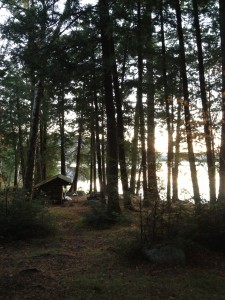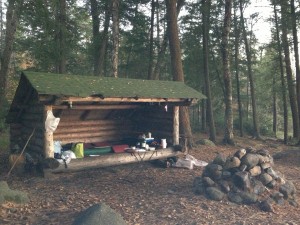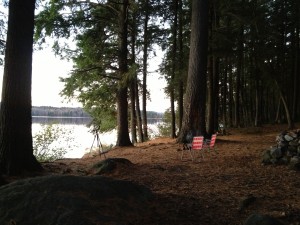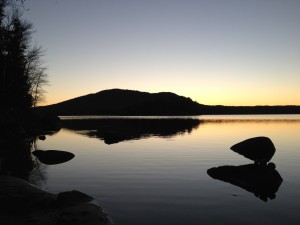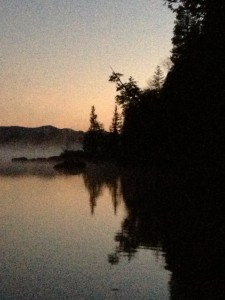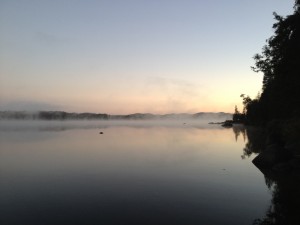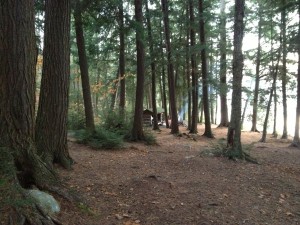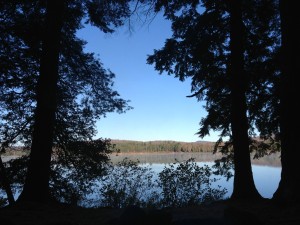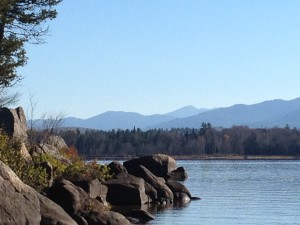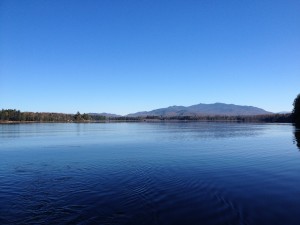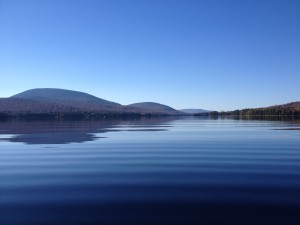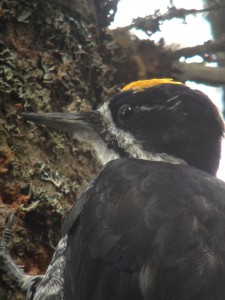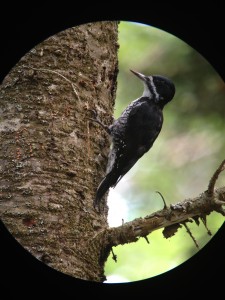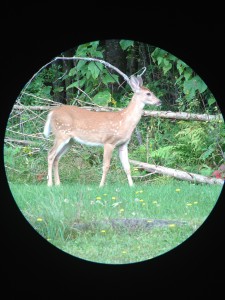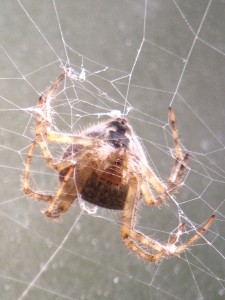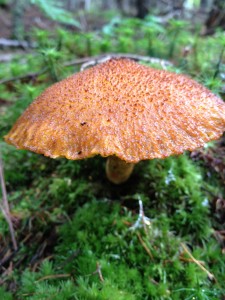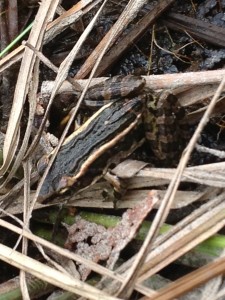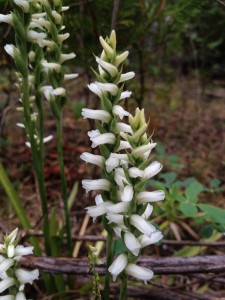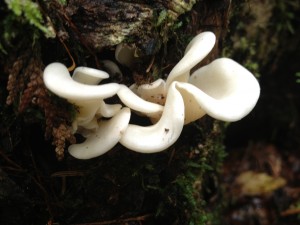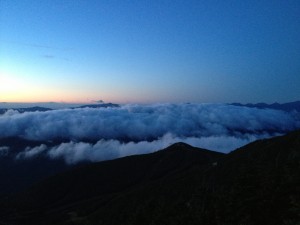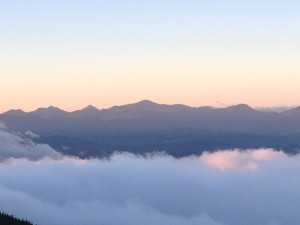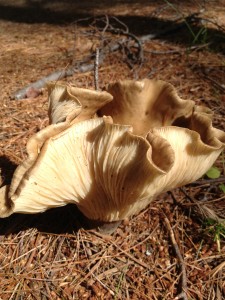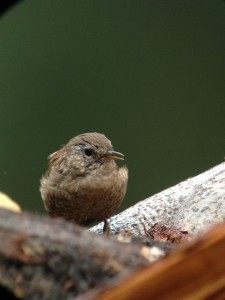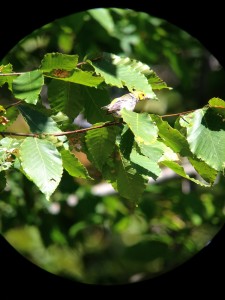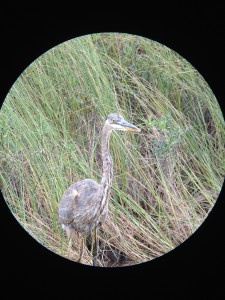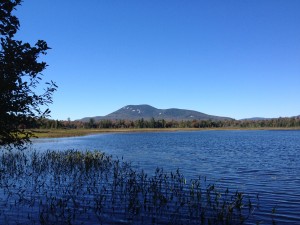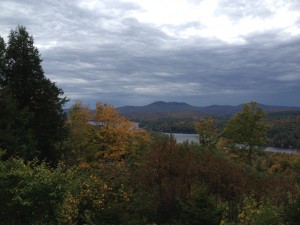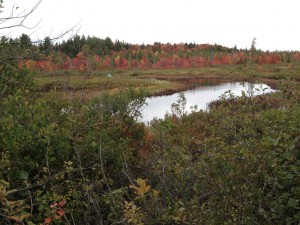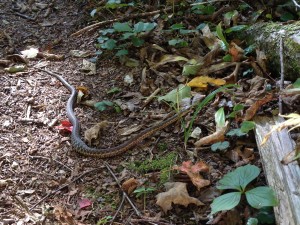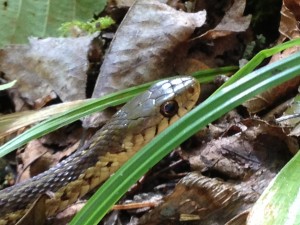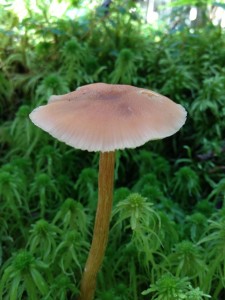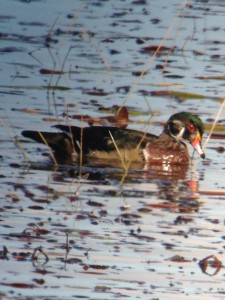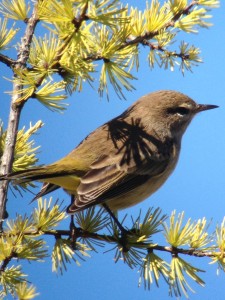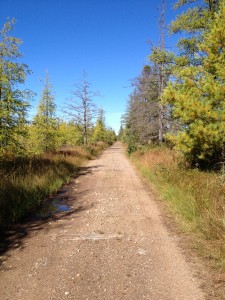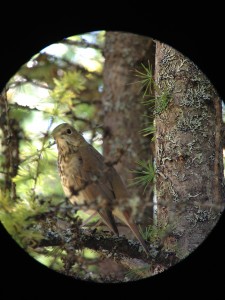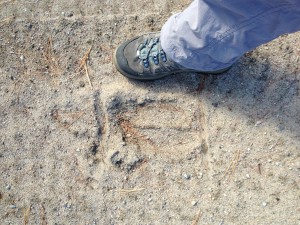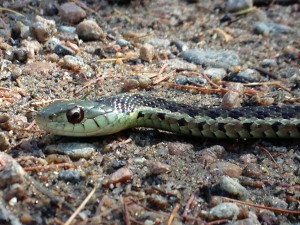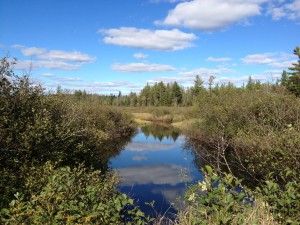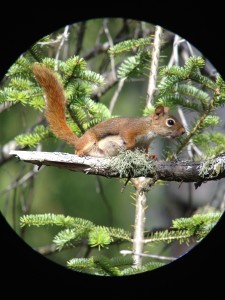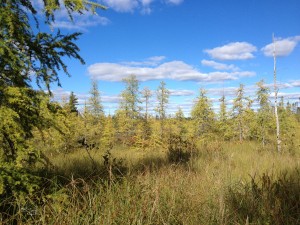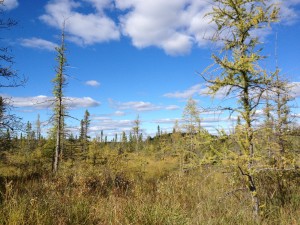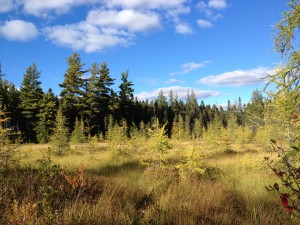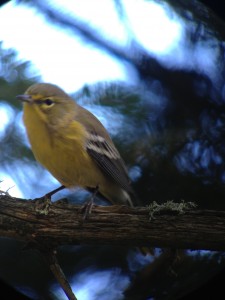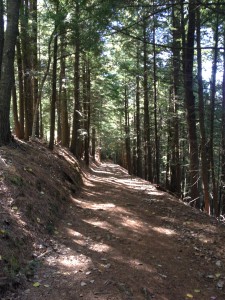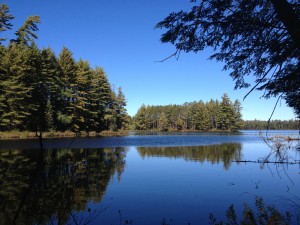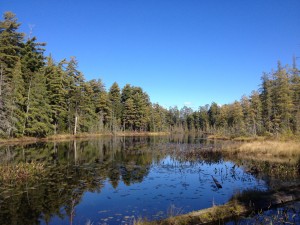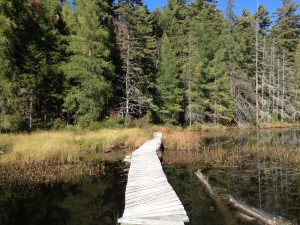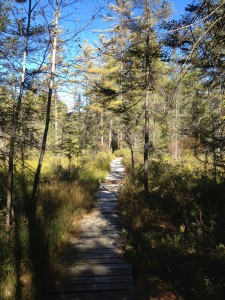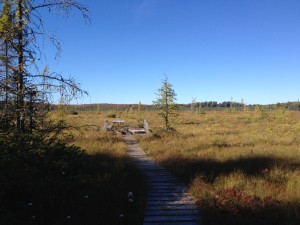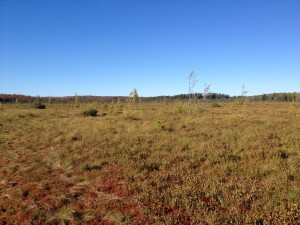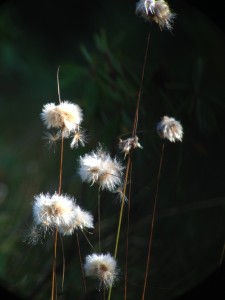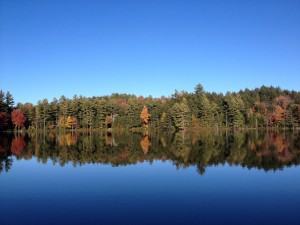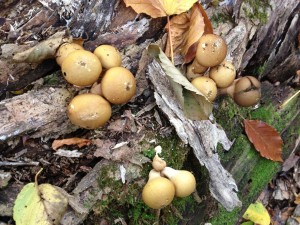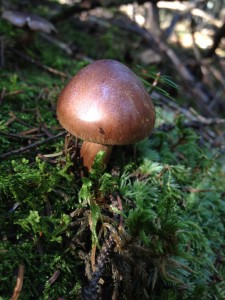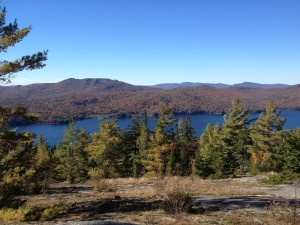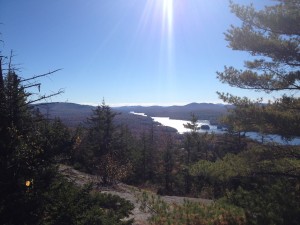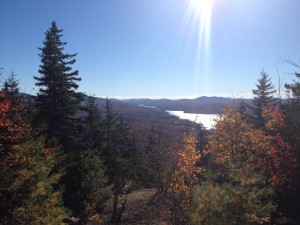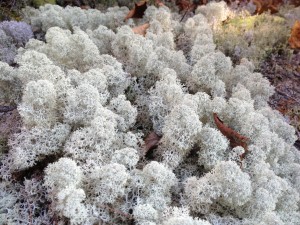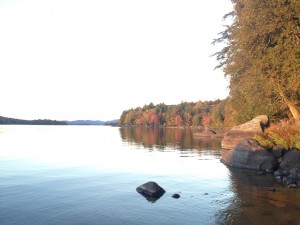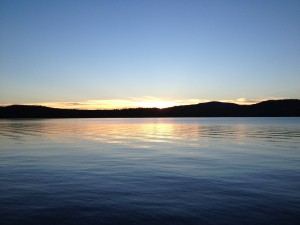Archive for October 2013
A Night Out in the Adirondack Wilderness
On Friday, October 11, 2013, my husband George and I camped at the “Island House” lean-to along the remote, north-end of 14-mile Long Lake (this lean-to has views across the lake of an island of the same name). We motored over 8 miles from our beach to this spectacular location about ¾ of a mile from the north end of the lake. This end of Long Lake is surrounded by Adirondack wilderness, with mostly boat-access-only camps, and lovely views of the High Peaks. In spring and fall, you can often have this end of the lake completely to yourself. It feels like paradise!
As we slowly motored north in our pontoon boat, a young Bald Eagle was also heading north and it flew parallel to our boat over the shoreline. Common Loons were numerous and molting into their duller winter plumage. Female Common Mergansers were diving for food. We passed Round Island, Camp Islands, Pancake Islands, and Island House before pulling up to our camp location. The lean-to was hidden up on a knoll of mature White Pine, Hemlock, and Birch trees.
As we pulled up to the shoreline, I noticed an Osprey perched about 75 feet away on a dead snag over the water. It was drenched from fishing. The bird took flight and actively fished for several minutes, dragging its feet and body across the lake in continuous, futile dive attempts to catch fish.
The sun was beginning to set, so we quickly set up the lean-to with our camping gear. As the light faded away, a Bald Eagle began to vocalize on the island across from our camp. This is the same island where Bald Eagles now nest each year. I found it interesting that they were still roosting at the nest location in October. Nearly dark now, a shorebird silhouette quickly flew along the shoreline.
George built a fire. The sky was clear and it was going to be a cold night.
Memories…
**********
I began to think about all the places I’ve camped around Long Lake in over a decade and a half. This location was the 12th different place, with well over 40 different camping trips across all four seasons. Some of the trips were at lean-to locations or designated tent areas, but many were bushwhack trips to wetlands or mountain summits along the lake. Many of the trips were with our two sons and their friends as they grew up. There were many humorous moments…
One time we camped in a lean-to location and found a large group of Girl Scouts in a nearby lean-to that sang non-stop until 1 a.m.!
Another time, I took my two sons and two Golden Retrievers to a lean-to location where a couple thru-hiking the 136-mile Northville-Placid Trail (which runs along Long Lake) showed up and used their tent so we could have the lean-to. Just as we were all heading to bed, the young man said, “Hey, one of my boots is missing”! Anyone who has spent time with Golden Retrievers knows exactly what happened! We all searched for hours with headlamps, and I finally offered to boat to town in the morning and buy the man a new pair of hiking boots (he still had 36 miles of wilderness to hike through). I imagined that my dog Max had dumped his boot in the lake! But by some miracle, Max got up at 3 a.m. and ran off into the woods, and returned with the missing boot! Phew!
On a solo camp trip to the very north end of the lake at Turtle Beach, I arrived at sunset to find a family of 3 (plus their son’s friend) with 3 large tents (one for the parents, one for the boys, and one for their toys…lots of toys!), furniture (tables, chairs, etc.), and enough lamps and lights that the place was lit up like a church. I stood speechless wondering how they fit it all in their boat. It felt as if they had brought suburbia to the wilderness! The next morning, as the family slept, I had coffee while watching an actively hunting Mink at the edge of the water!
During one of my difficult trips bushwhacking up Kempshall Mountain for the annual June Mountain Birdwatch survey, I found an older man and his son setting up a bivouac camp because they had been lost all day finding the summit and ran out of light to get down. They broke branches all night to keep a fire going, so I didn’t really sleep. I got up at 4 a.m. and began the survey at 4:30. I am sure they wondered what on Earth this woman was doing in the middle of nowhere counting birds at dawn! After the survey, I offered to lead them back to their campsite on the lake. They fell several times on the descent (1800’ of elevation over 2 miles) and I noticed one was in sandals and one in sneakers!
Another time, I bushwhacked to a wetland for the NYS Breeding Bird Atlas work. Something began to charge my tent in the dark, which I immediately imagined to be a Black Bear. I was thrilled to find an aggressive Ruffed Grouse in the light of my headlamp instead!
One winter, I camped without a tent near another wetland on top of several feet of snow, and 3 different coyote packs howled around me from the forest – all I could think about was whether they might accidently step on me in the night!
During a summer trip in August, with my sons, and a friend and her teenage daughter, we camped at Plumley’s lean-to. I forgot about insects at that time of year and the mosquitoes were horrendous! The teenage girl declared in a terse statement that she would sit up all night by the fire rather than deal with the bugs attacking her head in the sleeping bag!
Some trips turned into interesting learning experiences. On a bushwhack up Rock Pond Mountain (also for Atlas work), I first realized that jet plane noise really bothers birds during the night. I was awakened all night by vocalizing Common Loons, and songbirds actively moving and making small sounds in the dark – and a few seconds later, I would hear a jet plane go over. The birds were able to hear the jet a few seconds before my ears could pick it up. I’ve since noticed this correlation on other camping trips. I suspect that the huge 4th of July fireworks display over Long Lake each year is frightening to the birds, and no doubt to other wildlife too.
**********
Anyway, our current camp trip was in perfectly calm winds, clear skies, chilly temps, with a waxing moon in the sky. During the night, I heard two Barred Owls vocalizing. Barred Owls, like Common Ravens, seem to have an endless array of vocalizations, and I had never heard this particular sound from them. In my sleep haze, I memorized a mnemonic so I could recall it for my friend Sean O’Brien who does recordings for the Cornell Lab of Ornithology. Of course, I couldn’t remember it in the morning! My husband said he also awakened to the owls. Throughout the night, we heard the haunting calls of Common Loons piercing the world.
George and I got up at 4:30 a.m. (our normal wake-up time) with over two hours of darkness before dawn! A Fox gave its scary scream across the lake. The stars were spectacular and mirrored in the smooth surface of Long Lake. Orion and the Big Dipper were visible. A couple different meteors streaked across the sky. I spent over 2 hours captivated at the edge of the lake with completely numb feet. I live for these moments. “Dawn is a feeling” kept going through my head as I watched all the fascinating changes as the Earth rotated east toward “day”. I could hear a few migrant voices flying over in the dark. By 6:15 a.m., migrant Hermit Thrushes and a few sparrows began their descent – this continued until about 6:25 a.m. Long before dawn, the Bald Eagle began to vocalize again on its island roost. A coyote pack howled somewhere at the north end of the lake. Two Barred Owls called across the lake, and a third started up across the lake behind the eagle island. Barred Owl vocalizations seem so much louder along the lake. Song Sparrows sang at dawn. Pileated Woodpeckers called. A Belted Kingfisher rattled. A migrant Greater Yellowlegs called. Migrant Ruby-crowned Kinglets filled the bushes. Hardy Yellow-rumped Warblers were numerous. Over 30 species were found between dusk and dawn on this trip.
I photographed the north end of the lake and the eagle island as my eyes began to detect light. I wanted to see what time my eyes would go from “gray” to sensing “color” (rods to cones) – it was 6:40 a.m.!
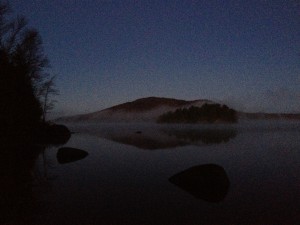
One: Looking out at the island with nesting eagles at dawn from Island House lean-to on Long Lake. Taken on October 12, 2013.
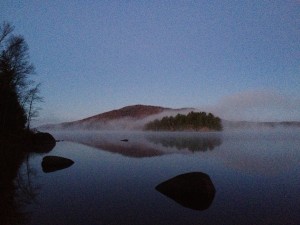
Two: Looking out at the island with nesting eagles at dawn from Island House lean-to on Long Lake. Taken on October 12, 2013.
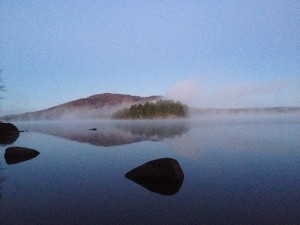
Three: Looking out at the island with nesting eagles at dawn from Island House lean-to on Long Lake. Taken on October 12, 2013.
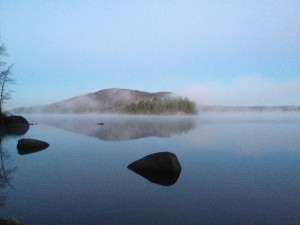
Four: Looking out at the island with nesting eagles at dawn from Island House lean-to on Long Lake. Taken on October 12, 2013.
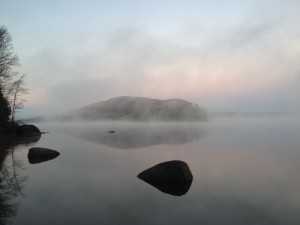
Five: Looking out at the island with nesting eagles at dawn from Island House lean-to on Long Lake. Taken on October 12, 2013.
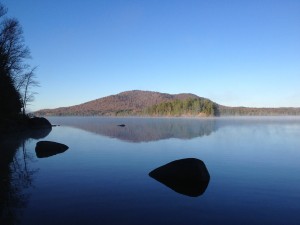
Six: Looking out at the island with nesting eagles at dawn from Island House lean-to on Long Lake. Taken on October 12, 2013.
I spotted an adult Bald Eagle perched in a dead snag on the island. I got my scope to photograph it with my iPhone attachment, but a large bank of fog rolled in and obscured the bird. Later, as we began to break down our camp, we observed two other Bald Eagles flipping and latching talons over the lake! About 10 minutes after hearing several gun shots at the north end of Long Lake (duck hunting season), I spotted a white-headed, white-tailed bird in the water with my scope. It was in the fog about ¾ of a mile away. It quickly became apparent it was an adult Bald Eagle struggling in the water. I observed it for about 15 minutes using its wings as paddles to reach the shoreline. I was sick wondering if a hunter had shot it. Even on the shore, the bird was unable to take off. I called my husband to come to the lake, and we decided to take the boat to the bird to see if it was hurt. While we discussed this, I noticed the eagle was eating – it no doubt had a very heavy fish (out of our view in all the fog) that made it impossible for the eagle to take flight! I wish I could have seen that fish!
One of the many documented effects of climate change in our area is the ice-on and ice-off dates. Historically, October was a cold month, and major snowstorms were common. Now, falls are warm, and the ice-on date has moved out nearly two months to December. Common Loons stay two months longer now, and sea planes and boats remain on the lakes into December. Snow often does not arrive to stay until January. The spring ice-off date has moved back about a month. These are rapid, unprecedented changes with frightening impacts on both flora and fauna. I reminded my husband that back in the late 1990s, October 11th would have been cold and possibly snowy. But the October of a rapidly warming world in 2013, was in the 60s on the 11th and went up to the 70s on the 12th as we boated home. “Normal” no longer seems to apply because the climate just keeps changing year to year. Tourists and summer residents still focus on July and August for visiting. Those of us fortunate enough to live here year-round have gained several months of quiet boating time on the lakes. I would gladly trade this benefit of climate change if I could turn back the clock on atmospheric CO2 to pre-industrial revolution levels…
September 2013 Tours and a few other Sightings
***For photos taken in September 2013, see the photographic blog post, “September 2013 Photographs”.***
September 1, 2013
On a drive of Sabattis Circle Road in Long Lake (26 species):
Wild Turkey with young
Great Blue Heron
Broad-winged Hawk
American Kestrel
Belted Kingfisher
Black-backed Woodpecker – male & female
Blue-headed Vireo
Red-eyed Vireo
Blue Jay
Black-capped Chickadee
Red-breasted Nuthatch
Brown Creeper – singing
Winter Wren
Golden-crowned Kinglet
Cedar Waxwing
Nashville Warbler
Magnolia Warbler
Black-throated Blue Warbler – singing
Yellow-rumped Warbler
Black-throated Green Warbler
Black-and-white Warbler – singing
Common Yellowthroat
Chipping Sparrow
Song Sparrow – no tail juvenile
White-throated Sparrow
American Goldfinch
***********************
September 2, 2013
A few species at dawn outside our Long Lake home:
Common Loon – calls echoing up our mountain (The Pinnacle) from the lake
Pileated Woodpecker
Winter Wren – singing (juvenile observed)
Swainson’s Thrush – several migrants
Hermit Thrush – calling
Ovenbird
Other wildlife – a male deer, two females, and a fawn are regulars each day, also a flock of 17 Wild Turkeys (often they are all together), and an Eastern Coyote has been hunting along the edge of our lawn.
***********************
September 3, 2013
Hanging Spear Falls Trail (High Peaks area)
This was an afternoon berry picking trip, but I still noted a few species:
Swainson’s Thrush
Hermit Thrush
Scarlet Tanager
The suspension bridge over the Hudson River is still out 2.5 years after it washed out in the floods of April 2011. I had to wade across. Also, the boardwalk over Lake Jimmy washed out this year in flooding, so the trail has been re-routed around the lake (to the north).
***********************
September 4, 2013
Whiteface Mountain summit at dawn (high winds), Bloomingdale area, and Tupper Lake Causeway (44 species):
Canada Goose
Wood Duck
Amer. Black Duck
Mallard
Ring-necked Duck
Wild Turkey
Great Blue Heron
Turkey Vulture
Osprey
Amer. Kestrel – 2
Ring-billed Gull
Mourning Dove
Belted Kingfisher
Hairy Woodpecker
Northern Flicker
Pileated Woodpecker
Eastern Phoebe
Red-eyed Vireo
Blue Jay
Amer. Crow
Common Raven
Black-capped Chickadee
Boreal Chickadee – 8
Red-breasted Nuthatch
Winter Wren – singing
Golden-crowned Kinglet
Eastern Bluebird
Bicknell’s Thrush – 15 to 20 birds calling (one song)
Amer. Robin
European Starling
Cedar Waxwing
Nashville Warbler
Chestnut-sided Warbler
Cape May Warbler
Yellow-rumped Warbler
Black-throated Green Warbler
Blackpoll Warbler – singing
Black-and-white Warbler
Common Yellowthroat
Chipping Sparrow
Song Sparrow
White-throated Sparrow
Dark-eyed Junco
Amer. Goldfinch
***********************
September 6, 2013
On a tour with a birder from North Carolina, we visited Sabattis Circle Road (including Sabattis Bog), Tupper Lake Marsh, Lake Durant, Moose River Plains, and Raquette Lake. Here are the 46 species found:
Wood Duck
American Black Duck
Ring-necked Duck
Wild Turkey
Common Loon – an adult on Lake Durant, and an adult with a chick on Raquette Lake
Great Blue Heron – many
Osprey
Sharp-shinned Hawk – 4
Cooper’s Hawk – 2
Broad-winged Hawk
Red-tailed Hawk
Belted Kingfisher – several
Yellow-bellied Sapsucker – 1 adult and 1 juvenile
Hairy Woodpecker
Northern Flicker – many
Pileated Woodpecker
Eastern Phoebe
Blue-headed Vireo
Red-eyed Vireo
Gray Jay – heard
Blue Jay
American Crow
Common Raven
Black-capped Chickadee
Boreal Chickadee – Helldiver Pond
Red-breasted Nuthatch
Winter Wren
Golden-crowned Kinglet
Ruby-crowned Kinglet
Hermit Thrush
American Robin
Gray Catbird
Cedar Waxwing
Chestnut-sided Warbler
Magnolia Warbler
Black-throated Blue Warbler
Yellow-rumped Warbler
Black-throated Green Warbler
Blackburnian Warbler
Common Yellowthroat
Song Sparrow
Swamp Sparrow
White-throated Sparrow
Dark-eyed Junco
Common Grackle
American Goldfinch
***********************
September 7, 2013
On a tour with a couple from Virginia, we visited Whiteface Mountain at dawn, and lowland mixed and boreal habitat areas. Here are the 42 species found:
Double-crested Cormorant – on Lake Flower
Turkey Vulture
American Kestrel – male
Ring-billed Gull
Rock Pigeon
Mourning Dove
Belted Kingfisher
Downy Woodpecker
Hairy Woodpecker
Northern Flicker
Pileated Woodpecker
Blue-headed Vireo
Red-eyed Vireo
Gray Jay – 12! (Groups of 4, 3, and 5); including one Gray Jay with a mushroom cap in its bill!
Blue Jay
American Crow
Common Raven
Black-capped Chickadee – still feeding young!
Boreal Chickadee – 8! (Groups of 5, 2, and 1)
Red-breasted Nuthatch
Brown Creeper
Winter Wren – singing
Golden-crowned Kinglet
Ruby-crowned Kinglet
Bicknell’s Thrush – 15 calling birds!; one partial song at dawn
American Robin
Gray Catbird
Cedar Waxwing – feeding young!
Nashville Warbler
Chestnut-sided Warbler
Magnolia Warbler
Black-throated Blue Warbler
Yellow-rumped Warbler
Black-throated Green Warbler
Common Yellowthroat
Song Sparrow
Swamp Sparrow
White-throated Sparrow
Dark-eyed Junco
Rose-breasted Grosbeak
American Goldfinch
We also found large Moose tracks!
***********************
September 9, 2013
On a hike at Massawepie Mire with David Buckley, we found the following 45 species:
Canada Goose – a few flocks overhead
Wood Duck
Common Loon
Turkey Vulture
Bald Eagle
Broad-winged Hawk
Amer. Kestrel
Merlin
Black-billed Cuckoo – great views! It was giving its amphibian-sounding call (heard also on migration)
Yellow-bellied Sapsucker
Hairy Woodpecker
Black-backed Woodpecker – male
Northern Flicker
Pileated Woodpecker
Blue-headed Vireo
Red-eyed Vireo
Gray Jay – 7 (groups of 2 and 5)
Blue Jay
Common Raven
Black-capped Chickadee
Boreal Chickadee – 7 (groups of 3 and 4)
Red-breasted Nuthatch
Winter Wren – singing
Golden-crowned Kinglet – singing
Veery – several migrants foraging among Amer. Robins (lots of skirmishes between these 2 species), Cedar Waxwings, and White-throated Sparrows
Swainson’s Thrush – 1
Hermit Thrush – several
American Robin
Cedar Waxwing
Northern Parula – singing
Magnolia Warbler – several
Cape May Warbler – 3 observed
Yellow-rumped Warbler – abundant
Blackburnian Warbler – 1
Pine Warbler – 1
Palm Warbler – abundant
Common Yellowthroat – several; some singing
Wilson’s Warbler – 1
Scarlet Tanager – 1
Song Sparrow
Lincoln’s Sparrow – several observed, and one sang once!
White-throated Sparrow – abundant
Dark-eyed Junco
Purple Finch
American Goldfinch
We also observed a Bobcat at 10:30 a.m.!
***********************
September 13, 2013
A few species outside our Long Lake house at dawn:
Ruby-throated Hummingbird
Northern Flicker
Blue-headed Vireo
Red-eyed Vireo
Winter Wren
Amer. Robin
Black-throated Green Warbler
Blackburnian Warbler
Blackpoll Warbler
Black-and-white Warbler
Scarlet Tanager
***********************
September 14, 2013
On a drive along Sabattis Circle Road:
Great Blue Heron
Ruby-throated Hummingbird
Northern Flicker
Gray Jay – two different places
Brown Creeper
Winter Wren
Golden-crowned Kinglet
Cedar Waxwing
Northern Parula
Magnolia Warbler
Black-throated Blue Warbler
Yellow-rumped Warbler
Black-throated Green Warbler – feeding young in a family group
Palm Warbler
Black-and-white Warbler
Ovenbird
Song Sparrow
Swamp Sparrow
White-throated Sparrow
***********************
September 15, 2013
At the Tupper Lake causeway with Pat & John Thaxton, after our Northern NY Audubon board meeting, we observed a western (brown) Palm Warbler migrant, and a Common Yellowthroat.
***********************
September 17, 2013
Some of the species along Powley Place Rd. in southern Hamilton Co.:
Ruffed Grouse – drumming
Yellow-bellied Sapsucker
Hairy Woodpecker
Northern Flicker
Blue-headed Vireo
Philadelphia Vireo
Hermit Thrush
Black-throated Blue Warbler
Yellow-rumped Warbler
Palm Warbler – western (brown) migrant
Common Yellowthroat
Chipping Sparrow
Lincoln’s Sparrow
White-throated Sparrow
***********************
September 18, 2013
Outside our Long Lake house, Swainson’s Thrush migrants continue to be observed. A juvenile, female Ruby-throated Hummingbird continues at our feeders (see below…9/8 is the typical late date for our home).
***********************
September 23, 2013
This was the last day I observed the juvenile, female Ruby-throated Hummingbird at our Long Lake feeders! I was able to take photos of the bird that day. This is a record late date for our location, and it came close to the late date for our county. (I returned from a trip to Iowa on 8/26/13 and all the males were already gone.)
***********************
September 24, 2013
Thirty-three species from outside our Long Lake house and along Sabattis Circle Road:
Canada Goose
Wood Duck
Wild Turkey
Bald Eagle
Amer. Kestrel
Yellow-bellied Sapsucker
Black-backed Woodpecker
Northern Flicker
Blue-headed Vireo
Red-eyed Vireo – feeding young
Gray Jay – 6 (groups of 3 and 3)
Blue Jay
Common Raven
Black-capped Chickadee
Red-breasted Nuthatch
Brown Creeper
Winter Wren
Golden-crowned Kinglet
Swainson’s Thrush
Hermit Thrush
Amer. Robin
Nashville Warbler
Northern Parula
Black-throated Blue Warbler
Yellow-rumped Warbler
Black-throated Green Warbler
Blackburnian Warbler
Blackpoll Warbler
Song Sparrow
White-throated Sparrow
**White-crowned Sparrow – first of the season
Rusty Blackbird – vocalizing near Sabattis Bog
Amer. Goldfinch
***********************
September 25, 2013
Out at 1 a.m. listening to migrants overhead; outside our house at dawn; along the Northville-Placid Trail (S) in Long Lake; and back outside at 9:30 p.m. for more migrants!
At 1 a.m. – many Common Loon vocalizations echoing up from the lake, two Barred Owls vocalizing back and forth, lots of migrant birds flowing overhead including Swainson’s Thrushes, two coyote packs howling, and the spectacular stars (with the Milky Way band evident) and moon!
At dawn – Blue-headed Vireo, Brown Creeper (singing), Winter Wren, Swainson’s Thrush, Hermit Thrush, American Robin (eating the Hawthorn tree berries), Black-throated Blue Warbler, Yellow-rumped Warbler, and Blackpoll Warbler.
Along the N-P Trail – Boreal Chickadee and Winter Wren
Back out at 9:30 p.m. – Common Loons and two Barred Owls vocalizing again, plus migrants overhead.
***********************
September 26, 2013
Forty-five species found at the Tupper Lake Causeway and Massawepie Mire:
Canada Goose
Wood Duck
Amer. Black Duck
Mallard
Ring-necked Duck
Ruffed Grouse – 2
Common Loon
Great Blue Heron
Turkey Vulture
Red-tailed Hawk
Amer. Kestrel
Rock Pigeon
Mourning Dove
Belted Kingfisher
Hairy Woodpecker
Black-backed Woodpecker
Northern Flicker
Pileated Woodpecker
Blue-headed Vireo – singing
Gray Jay – 4 (groups of 2 and 2)
Blue Jay
Amer. Crow
Common Raven
Black-capped Chickadee
Boreal Chickadee – at least 4
Red-breasted Nuthatch
Brown Creeper – singing
House Wren! (This is the 3rd time I’ve found this species at Massawepie over the years.)
Winter Wren
Golden-crowned Kinglet
Ruby-crowned Kinglet
Eastern Bluebird (Tupper Lake)
Hermit Thrush
Amer. Robin
Cedar Waxwing
Yellow-rumped Warbler – many
Palm Warbler – many
Common Yellowthroat
Song Sparrow
Swamp Sparrow – several
White-throated Sparrow
White-crowned Sparrow
Dark-eyed Junco
Purple Finch
Amer. Goldfinch
***********************
September 28, 2013
Thirty-four species were found at the Tupper Lake Causeway, Mountaineer Trail (at Massawepie), Viewing Deck at Massawepie, and Deer Pond at Massawepie:
Canada Goose
Wood Duck
Amer. Black Duck
Mallard
Ring-necked Duck
Ruffed Grouse – 2 (one was drumming)
Common Loon – Long Lake and Deer Pond
Great Blue Heron
Ring-billed Gull
Rock Pigeon
Mourning Dove
Northern Flicker
Pileated Woodpecker – 5 along the Mountaineer Trail – calling and drumming
Gray Jay – 2
Blue Jay
Amer. Crow
Common Raven
Black-capped Chickadee
Red-breasted Nuthatch
Brown Creeper – singing
Winter Wren
Golden-crowned Kinglet
Ruby-crowned Kinglet
Hermit Thrush
Amer. Robin
European Starling
Cedar Waxwing
Yellow-rumped Warbler
Pine Warbler – singing
Common Yellowthroat
Swamp Sparrow
White-throated Sparrow
Dark-eyed Junco
Amer. Goldfinch
***********************
September 29, 2013
My husband George and I took our pontoon boat to Kempshall Landing along Long Lake. We bushwhacked up the north side of Blueberry Mountain and came down the south side cliffs. We followed a remnant tote road between Blueberry Mountain and Landing Hill back to the Northville-Placid Trail. There are many active beaver locations along the tote road. We followed the N-P Trail back to our boat by sunset. I counted TWENTY-ONE Common Loons to our north at Camp Islands!!! This is the largest gathering I’ve observed on Long Lake.
***********************
September 30, 2013
Outside our Long Lake house at dawn, a Blue-headed Vireo and Brown Creeper sang.
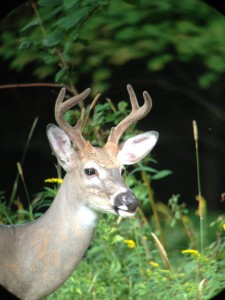
Male White-tailed Deer transitioning from its summer-red coat to the winter-gray coat. Taken outside our Long Lake house on 9/2/13.
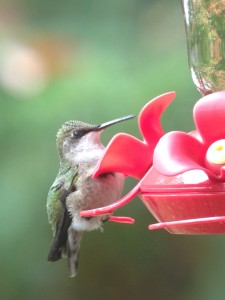
Female, juvenile Ruby-throated Hummingbird that visited our Long Lake feeders until September 23, 2013 – very late for this species.
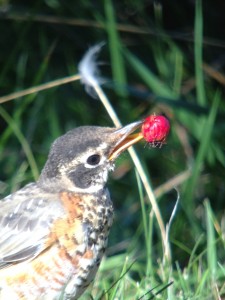
American Robin eating a Hawthorn berry outside our Long Lake home on September 25, 2013. Hoards of robins descend on this tree each fall!
